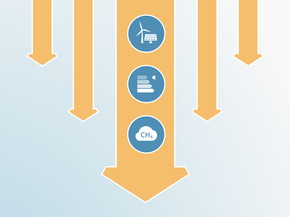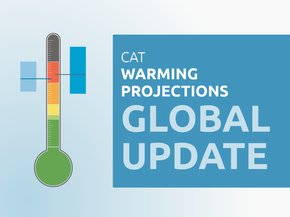Current Policy Projections
Economy-wide
In the CAT current policy projections, China will reach a GHG emissions level (excl. LULUCF) of between 13.2 and 13.5 GtCO2e/yr in 2020 and 14.4–15.8 GtCO2e/yr in 2030. A total of 9.2–9.4 GtCO2e/yr in 2020 and 9.4–10.8 GtCO2e/yr in 2030 are energy-related CO2 emissions. This is an increase in total GHG emissions of 4%–6% above 2015 levels by 2020 and 14%–25% by 2030.
This means that according to our assessment, China will meet its 2020 pledge and its NDC targets, but still be above current emissions levels. The projected increase in emissions is mostly related to emissions of gases other than CO2, because in the lower range of the current policy projections, overall CO2 emissions flatten between 2015 and 2020. China’s chief climate negotiator, Xie Zhenhua, has expressed the opinion that China could meet its 2030 target early (Xu, Stanway, & Daly, 2018). CAT analysis confirms that, based on current GDP projections, China is indeed likely to meet the carbon intensity target of its 2030 pledge early, and could also reach peak CO2 emissions early under optimistic assumptions.
China is implementing a range of policies in most sectors. Most significant is its commitment to limit coal use, and a strong increase of renewable and low-carbon energy. In December 2017, China announced a new national emissions trading system, which will initially apply only to the power sector, but may be expanded to other sectors in the future. The overall emissions impact of the system is not yet clear, as many operational details are still to be shared, including the start date and the level and distribution of emissions allowances (Jotzo et al., 2018).
Energy supply
Controlling coal consumption
In 2016, coal accounted for 65% of China’s total primary energy supply, and 69% of its electricity production (IEA, 2018c). In that year, China accounted for 51% of the world’s primary coal energy supply (IEA, 2018c). China’s actions on coal are therefore key to limiting global coal consumption: globally, coal in primary energy will need to decrease by 97% compared to 2010 levels by 2050 to be compatible with 1.5°C pathways, unless large scale carbon capture and storage technology becomes available (IPCC, 2018). Coal will also need to be completely phased out of the electricity supply by 2050, meaning that the no new coal fired power plants can be built as of now (Climate Action Tracker, 2016). This was confirmed in the recent IPCC report (IPCC, 2018).
Controlling and decreasing coal consumption is a policy objective in China’s National Action Plan on Climate Change, Energy Development Strategy Action Plan (2014–2020), and 2015–2020 Action Plan on the Efficient Use of Coal. The 13th Five Year Plan period (2016–2020) introduced more coal-related targets, such as a ban on new coal-fired power plants until 2018, and a cut in production capacity of coal (Enerdata, 2016). To combat air pollution, China is shutting down some coal-fired power plants, for example in Beijing, where the last remaining coal fired power plant was shut down in 2017 and replaced with gas power plants (Xinhua, 2017). China’s plan for continuing to curb air pollution between 2018 and 2020 extends air pollution targets to a wider range of cities (Feng, 2018a). The Chinese government is also pushing a switch from coal to gas in homes and factories, and gas consumption rose 15% in 2017 over 2016 levels (Chen, 2018).
Despite these efforts, coal consumption rose again in 2017 and 2018, after three consecutive decreasing years between 2013 and 2016. Some plants in China are being retrofit to use coal more efficiently (NEA, 2018). In 2018, loosened regulations allowed a restart on new coal plant construction after a two-year freeze, primarily in response to increased industrial electricity demand (Feng, 2018b). An analysis by CoalSwarm found that 259 GW of coal capacity are under development in China, about as much is installed in the United States, which, if installed, would increase China’s coal capacity by 25% (Shearer, Yu, & Nace, 2018). Increased policy effort will be needed to turn China’s coal consumption around and align it with a 1.5°C compatible pathway.
On the production side, China’s National Development and Reform Commission (NDRC), has issued, in its government work report, targets to cut annual coal production capacity by 150 million tonnes in 2018. This may not lead to immediate reductions in output, due to overcapacities in the sector (Platts, 2018).
In detail, coal consumption in China may already have peaked in 2013, as it dropped 2.9% in 2014, by 3.7% in 2015 and by 4.7% in 2016. This appears to be mainly due to two factors: a decline in growth in the construction and manufacturing sector as a result of the overall slowdown of China’s economic growth, as well as a continued policy drive to lower coal use in order to reduce air pollution and greenhouse gas emissions (Korsbakken & Peters, 2017; Qi, Stern, Wu, Lu, & Green, 2016). However, coal consumption rose 0.3% in 2017, largely driven by increased electricity demand, but stayed below its 2013 peak (IEA, 2018b). In the first half of 2018, Chinese coal consumption rose 3.1% over the same period in the previous year, responding to increased electricity demand partially driven by industrial rebound (Feng, 2018b).
In our current policy projections (see Assumptions below), coal’s share in China’s total primary energy demand decreases from 58% in 2017 to between 39 and 48% in 2030. As a result, and assuming growing energy demand, CO2 emissions could either flatten or continue to rise.
Renewable energy targets
In its 13th Five Year Plan period (2016–2020), China set the following targets for non-fossil capacity installed by 2020: 340 GW of hydropower capacity, 200 GW of wind power, 15 GW from biomass and 120 GW of solar power, as well as 58 GW of nuclear capacity (NDRC, 2016). As it turned out during 2017 that the solar target would be reached much earlier than 2020, the National Energy Administration adjusted it upward to 213 GW by 2020. Investment in renewable energy in China in 2017 reached $126.6 billion USD, accounting for 45% of global investment in renewables (Frankfurt School-UNEP Centre/BNEF, 2018).
News sources are reporting that the National Development and Reform Commission (NDRC) will increase the renewables target for 2030 to 35% of electricity consumption through the Renewable Portfolio Standard. This target would be met under the lower bound of the CAT’s current policies scenario. The plan would also increase 2018 and 2020 non-hydro power consumption targets for some provinces (Bloomberg News, 2018). However, the Chinese government abruptly reduced subsidies for solar installations in 2018, which is expected to lead to reduced installations (Baker, 2018).
Looking farther into the future, Bloomberg New Energy Finance projects that in 2050, China will have 1. TW of solar PV and 1 TW of wind power installed (BloombergNEF, 2018). Globally, renewables will need to supply 70–85% of electricity by 2050 to be compatible with a 1.5°C compatible pathway.
Industry
China’s energy intensity targets are supported by policies to reduce energy consumption. In the industrial sector, the TOP 1000 enterprises programme has led to effective energy savings, and has been extended to 10,000 installations.
In the steel sector, the 2018 government work plan set a target to cut production capacity by 30 million tonnes in 2018, which may not affect output due to overcapacities in the industry (Platts, 2018).
In 2014 and 2015, China also started to tackle non-CO2 emissions, most notably HFC emissions, some of the most potent greenhouse gases. The National Development and Reform Commission (NDRC) is investing in demonstration projects for the controlled disposal of HFCs in industry. Further, it is setting up a reporting and monitoring instrument for F-gases for industrial companies (ESCO Committee of China Energy Conversation Association 2015). The NDC document also states targeted reductions of HCFC22 production of 35% by 2020 and 67.5% by 2025 below 2010 levels, and also refers to controlling HFC23, which is largely a by-product of HCFC-22 production.
As there is no clear regulation that assures implementation of these targets, we have not included these reductions in the current policy projections. However, they are an important stepping stone towards tackling this sector (EIA 2015). China has not yet ratified the Kigali Amendment to the Montreal Protocol, which would require deeper emissions reductions.
In stark contrast to efforts to reduce HFCs, the widespread use of CFC-11, a globally banned ozone depleting substance (ODS) that is over 4,000 times more potent than CO2, has recently been identified and reported in China by the Environmental Investigation Agency, a UK based non-profit, suggesting enforcement challenges (Environmental Investigation Agency, 2018). In response, a spokesperson for the Chinese embassy in the UK sent a letter to The Guardian emphasising that the Chinese government does not tolerate the use of illegal ODSs and is investigating the use of CFC-11 (Rong, 2018).
Transport
The uptake of electric vehicles (full and hybrid) is happening faster and faster, with over 600,000 electric vehicles sold in China in 2017—a 2017 market share of 2.7% and nearly half of global electric vehicle sales (Pontes, 2018). At China’s 13th National People’s Congress in March 2018, the Chinese parliament extended tax subsidies on new energy vehicles for an additional three years (Platts, 2018). As of 2019, automakers will need to amass credits for the sale of new energy vehicles, making up 10% of annual sales in 2019 and 12% in 2020. Manufacturers could earn multiple credits for a single vehicle, meaning that the actual percentage of new energy vehicles sales could be lower than 10% of annual sales in 2019 and still comply with the standards (Shirouzu & Jourdan, 2017). New energy vehicles are a priority sector in China’s “Made In China 2025” policy initiative, which aims to comprehensively upgrade Chinese industries. For the auto industry, the strategy foresees fuel consumption standards of 5 ltrs/100 km in 2020, one million units of new energy vehicles sold in 2020, and world leadership in batteries and electric motors (China Daily, 2015). To limit global temperature increase to 1.5°C, the last fossil fuel car will need to be sold before 2035 (Climate Action Tracker, 2016).
China announced new emissions standards for heavy duty vehicles in June 2018, which will be implemented in two phases between 2019 and 2023. When fully implemented, these standards will be in line with standards in the US, Canada, Japan, and EU (Yang & He, 2018).
Buildings
China has mandatory energy efficiency codes for urban residential and commercial buildings, and promotes voluntary energy efficiency codes for rural residential buildings through financial incentives (GBPN, 2018). China’s 13th Five-Year plan includes targets for improving building energy efficiency standards and increasing the proportion of new “green buildings”, which will be particularly important for energy savings in the future, as China’s building stock is projected to continue to expand through 2030.
The government also provides incentives for retrofits of existing buildings to meet today’s more stringent building codes—under China’s 2013 Green Building Action Plan, all eligible buildings in the northern heating zone should be retrofit by the end of 2020 (ChinaFAQs, 2016). China also has two energy-labelling programmes for buildings, and the Three-Star Rating System for green buildings, which also takes into account other environmental considerations. For compatibility with the Paris Agreement temperature goals, all new buildings will need to be fossil free and near zero energy by 2020 and retrofit rates globally should increase to near 5%/year (Climate Action Tracker, 2016).
Forestry
China’s NDC pledges to increase forested area by 40 million ha by 2020 compared to 2005 levels, an area slightly larger than surface area of Norway, and in line with national forest strategies. China has implemented forest conservation policy through the early 21st century, beginning with the National Forest Protection Program, instituted in 1998, which aims to recover native forests, and has more recently been expanded to ban commercial logging in native forests. It is the largest forest conservation program in the world.
China also has a “compensation fund for ecological benefits,” and implemented the “Ecological Protection Redline” policy in 2017 to protect zones of high ecological importance (Hua, Xu, & Wilcove, 2017). Reforestation and afforestation efforts have led Chinese forest cover to increase from 12% of the land area in 1981 to 21.4% in 2013, according to national statistics. From an ecological perspective, however, some authors are concerned that reforestation programmes have created unintended incentives to cut down native forest to make room for monoculture forest crops (Hua et al., 2018). For Paris Agreement compatibility, sinks from the forestry sector should not be used as an excuse to not reduce emissions in other sectors (Climate Action Tracker, 2016).
Further analysis
Latest publications
Stay informed
Subscribe to our newsletter




